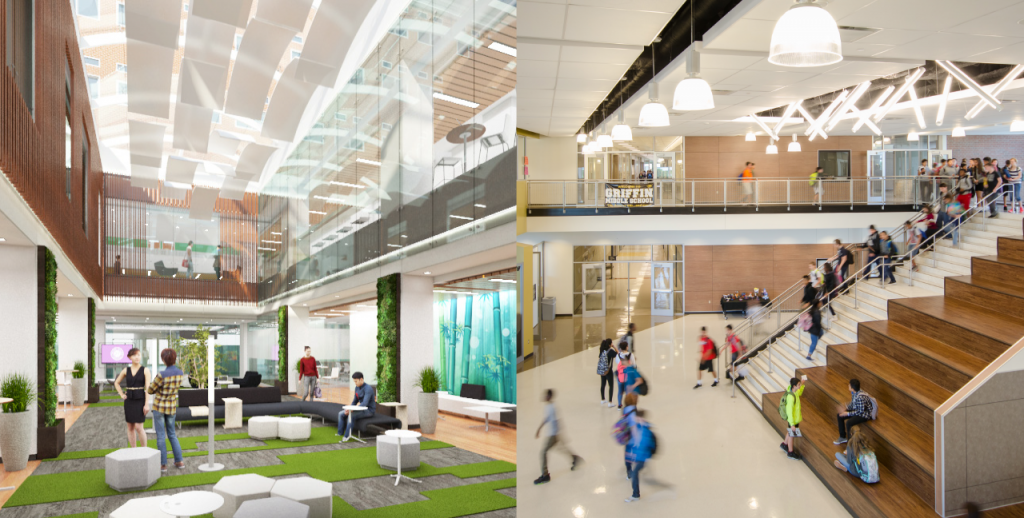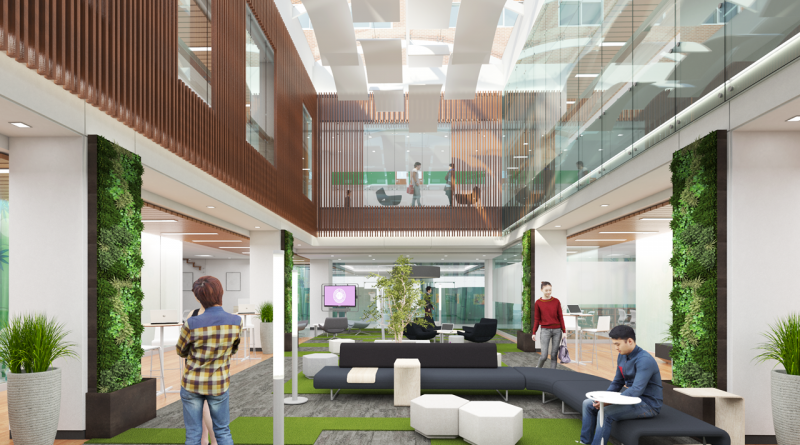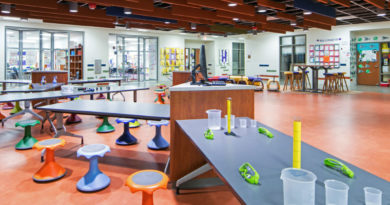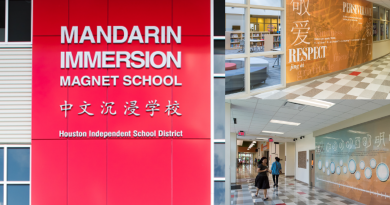AWE INSPIRING SCHOOLS
By Irene Nigaglioni, AIA, ALEP
I recently came across a CNN article entitled “Stress really is killing us,” which explained that as a society we are living with increasing levels of stress, and this stress is leading to early death rates. While this is disturbing, I was particularly troubled by the commentary about these levels of stress starting as early as infancy and negatively impacting school-aged children.
Students often come to school with extra baggage from home, whether it is lack of access to nutrition or other challenging living conditions. These are further exacerbated with stressful conditions in schools, such as bullying and pressure to perform on standardized tests. If we know these situations will take a negative toll on their health and may even contribute to earlier death rates, shouldn’t we rethink school design to combat these early stress-inducers?
Research from Nature.com shows stress can have an impact on memory retention, which can affect student success. While light to moderate stress activities, such as a new challenge or emotional trigger may positively impact learning, moderate to acute stress can negatively affect memory and create distraction in the memory formation process.
As I try to figure out what can be done, I think back to my training as an architect and planner, and my belief that we can design spaces to reduce stress and ignite learning. I am reminded of an article I read last year by Michelle Lani Shiota and the Greater Good Science Center. The article emphasized how we are better thinkers when we experience awe, as that feeling triggers a positive response within each of us. So, can school’s learning environments evoke awe in students in a way that can help mitigate stress and contribute to learning?
For example, building components such as lighting, ventilation and furniture can have a positive impact on learning by making each setting more comfortable for students. We have all been in old classrooms, or even offices, with a humming lighting ballast that distracts us from focusing on the task at hand. In addition, drastically cold or warm classrooms also won’t allow us to concentrate. As we design our school buildings, we must continue to look for ways to create better learning environments for students that do not contribute to student stress and negatively impact their ability to learn.
I strongly believe we can design learning environments that inspire and help us experience awe. For example, learning environments that have a visual connection to nature have been linked with lower levels of stress and have been shown to lower blood pressure and heart rate, which in turn results in improved mental engagement and attentiveness. In the cases where the visual connection cannot be reached- think back to interior classrooms that were built to save energy- the use of graphics or materials that evoke nature and its many forms can help reduce stress and improve creativity. Large graphic panels with images of trees and the sky can evoke feelings of awe, which can help minimize a stressful activity and make students more at-ease in their learning environment.

Mingde Academic Hall, Canvard College, Beijing (left) Griffin Middle School, Lewisville ISD, The Colony, Texas (right)
Biophilic design increases the opportunities for awe within the space. When designing schools, we consider each of biophilia’s fourteen patterns for stress reduction and improved cognitive performance. One of the patterns that helps me feel awe in the learning environments we design is “prospect.” This stress reduction occurs when a view is unimpeded over a large distance and can be used for surveillance and planning.
Many of our educational designs include areas with high volumes and clear views to the exterior in every direction. We can accomplish this with circulation areas that are simple and have minimal jogs and turns, as well as instructional spaces such as libraries that overlook outdoor courtyards filled with trees and vegetation. The larger volumes are inspiring, and the vistas evoke feelings of safety and comfort, thus reducing stress.

Beijing University of Aeronautics and Astronautics, Beijing
Awe can also be incorporated in each of the classroom spaces. Views to the exterior not only allow for the connection with nature but also for natural daylight to enter the space, creating shadows and patterns that vary throughout the day. These create interest, activating the brain to see what happens next. Combining natural light with diffused artificial lighting on the vertical and horizontal surfaces of the classroom helps create a visually pleasing environment that is calming. The material and color selection in the rooms should evoke natural hues, providing a warm and stimulating backdrop to learning.
All of these concepts, when used together, result in a space that is awe inspiring, safe and conducive for learning. As we design new learning spaces, or renovate old ones, we must consider the impact the built environment can have on student stress. By incorporating features that evoke awe and wonder, our schools can help nurture students’ creative minds.
———————–
About Irene Nigaglioni Irene Nigaglioni, AIA, ALEP, LEED AP BD+C is a partner at IN2 Architecture. Formerly, partner and national planning director for PBK, Irene offers varied experiences in programming, design and project management for institutional facilities. Specifically, Irene is one of the foremost industry experts in cutting-edge programming and has earned national recognition for her concentrated efforts in research and programming for educational facilities and outdoor environments.




